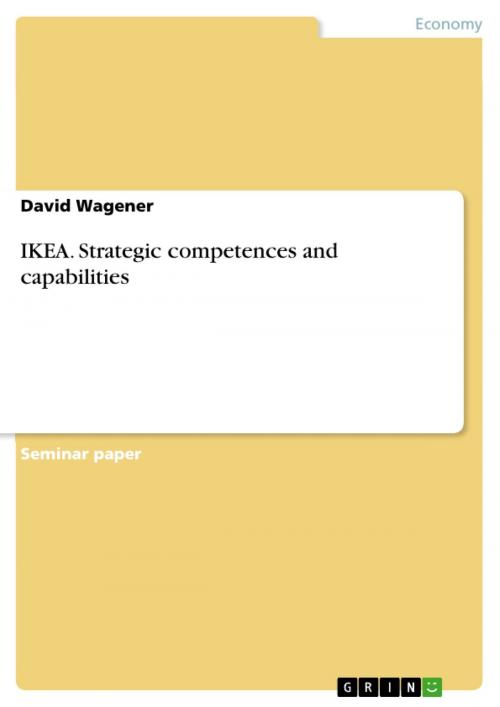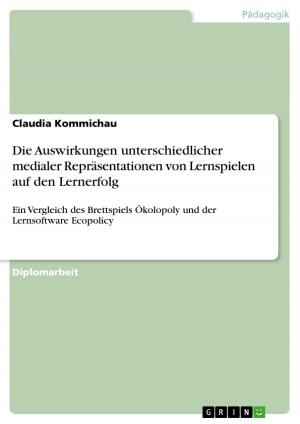IKEA. Strategic competences and capabilities
competences and capabilities
Business & Finance, Management & Leadership, Management| Author: | David Wagener | ISBN: | 9783640142477 |
| Publisher: | GRIN Verlag | Publication: | August 21, 2008 |
| Imprint: | GRIN Verlag | Language: | English |
| Author: | David Wagener |
| ISBN: | 9783640142477 |
| Publisher: | GRIN Verlag |
| Publication: | August 21, 2008 |
| Imprint: | GRIN Verlag |
| Language: | English |
Seminar paper from the year 2008 in the subject Business economics - Business Management, Corporate Governance, grade: 1,7, University of the West of England, Bristol (Bristol Business School (University of the West of England)), course: Strategisches Management, 12 entries in the bibliography, language: English, abstract: 231 stores in 24 countries, 522 million visitors during one year and nearly 20 billion euros in sales make IKEA the most successful furniture retailer in the world (IKEA, 2007; Sloan, 2007). In addition this is achieved without taking advantage of people or the environment, as one of IKEA's policies is to have an overall positive impact on both (Barner, 2007). But why is the Sweden-based company so successful? And how did it become that way? Which strategic issues did IKEA face? What are the values, resources and competences the company bases its operations on? In order to answer these questions this work uses two strategic frameworks. For the historic development of the company the 'dynamic competence and capability framework' is used. Furthermore the competitive edge IKEA has in comparison to its concurrence is explained with the 'static competences and capabilities framework', which is based on a company's special set of resources. Within this latter framework there is an emphasis on knowledge as a fundamental resource and on knowledge integration, which is separately discussed. The remainder of this work is therefore structured as follows. In the second section the frameworks of static and dynamic strategic competences and capabilities are explained. Afterwards, in the third part, the dynamic model is adopted to IKEA by applying it to some of the most important strategic decisions that led to the success of the company. Furthermore this paper is seeking to evaluate IKEA's current resources, competences and capabilities within the static competence and capability framework. Eventually the integration of knowledge at IKEA is examined. The analysis finishes with a conclusion revising the main points.
Seminar paper from the year 2008 in the subject Business economics - Business Management, Corporate Governance, grade: 1,7, University of the West of England, Bristol (Bristol Business School (University of the West of England)), course: Strategisches Management, 12 entries in the bibliography, language: English, abstract: 231 stores in 24 countries, 522 million visitors during one year and nearly 20 billion euros in sales make IKEA the most successful furniture retailer in the world (IKEA, 2007; Sloan, 2007). In addition this is achieved without taking advantage of people or the environment, as one of IKEA's policies is to have an overall positive impact on both (Barner, 2007). But why is the Sweden-based company so successful? And how did it become that way? Which strategic issues did IKEA face? What are the values, resources and competences the company bases its operations on? In order to answer these questions this work uses two strategic frameworks. For the historic development of the company the 'dynamic competence and capability framework' is used. Furthermore the competitive edge IKEA has in comparison to its concurrence is explained with the 'static competences and capabilities framework', which is based on a company's special set of resources. Within this latter framework there is an emphasis on knowledge as a fundamental resource and on knowledge integration, which is separately discussed. The remainder of this work is therefore structured as follows. In the second section the frameworks of static and dynamic strategic competences and capabilities are explained. Afterwards, in the third part, the dynamic model is adopted to IKEA by applying it to some of the most important strategic decisions that led to the success of the company. Furthermore this paper is seeking to evaluate IKEA's current resources, competences and capabilities within the static competence and capability framework. Eventually the integration of knowledge at IKEA is examined. The analysis finishes with a conclusion revising the main points.















